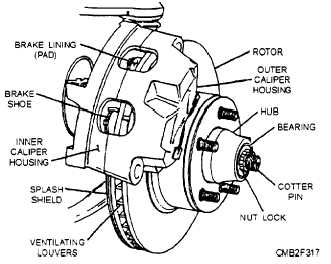Disc Brake Assembly
Disc brakes are basically like the brakes on a ten-speed bicycle. The friction elements are shaped like pads and are squeezed inwards to clamp a rotating disc or wheel. A disc brake assembly consists of a caliper, brake pads, rotor, and related hardware (bolts, clips, and springs), as shown in figure 7-16.
BRAKE CALIPER. - The caliper is the nonrotating unit in the system and it may be mounted to the spindle or splash shield to provide support. The brake caliper assembly includes the caliper housing, the piston(s), the piston seal(s), the dust boot(s), the brake pads or shoes, and the bleeder screw.
The caliper is fitted with one or more pistons that are hydraulically actuated by the fluid pressure developed in the system. When the brake pedal is applied, brake fluid flows into the caliper cylinder. The piston is then forced outward by fluid pressure to apply the brake pads to the rotor.
The piston seal in the caliper cylinder prevents pressure leakage between the piston and cylinder. The piston seal also helps pull the piston back into the cylinder when the brakes are released.
The elastic action of the seal acts as a spring to retract the piston and maintain a clearance of approximately 0.005 inch when the brakes are released. The piston boot keeps road dirt and water off the caliper piston and wall of the cylinder. The boot and seal fit into grooves cut in the caliper cylinder and piston.
A bleeder screw allows air to be removed from the hydraulic system. It is threaded into the top or side of

Figure 7-16. - Disc brake assembly.
the caliper housing. When loosened, system pressure is used to force fluid and air out of the bleeder screw.
DISC BRAKE PADS. - Disc brake pads consist of steel shoes to which the lining is riveted or bonded. Brake pad linings are made of either asbestos (asbestos fiber filled) or semimetallic (metal particle filled) friction material. Many new vehicles, especially those with front-wheel drive, use semimetallic linings. Semimetallic linings withstand higher operating temperatures without losing their frictional properties.
Antirattle clips are frequently used to keep the brake pads from vibrating and rattling. The clip snaps onto the brake pad to produce a force fit in the caliper. In some cases, an antirattle spring is used instead of a clip.
A pad wear indicator (a metal tab) informs the operator of worn brake pad linings. The wear indicator produces an audible high-pitch squeak or squeal, as it scrapes against the brake disc. This harsh noise is a result of the linings wearing to a point, allowing the indicator to rub against the brake disc, as the wheel turns.
BRAKE DISC. - Also called brake rotor, the brake disc uses friction from the brake pads to slow or stop the vehicle. Made of cast iron, the rotor may be an integral part of the wheel hub. However, on many front-wheel drive vehicles, the disc and hub are separate units.
The brake disc may be a ventilated rib or solid type. The ventilated rib disc is hollow that allows cooling air to circulate inside the disc.
Disc Brake Types
Disc brakes can be classified as floating, sliding, and fixed caliper types. Floating and sliding are the most common types. The fixed caliper may be found on older vehicles.
FLOATING CALIPER. - The floating caliper type disc brake (fig. 7-17) is designed to move laterally on its mount. This movement allows the caliper to maintain a centered position with respect to the rotor. This design also permits the braking force to be applied equally to both sides of the rotor. The floating caliper usually is a one-piece solid construction and uses a single piston to develop the braking force.
Operation of a floating caliper is as follows:
Fluid under pressure enters the piston cavity and forces the piston outward. As this happens the brake pad contacts the rotor.Continue Reading
